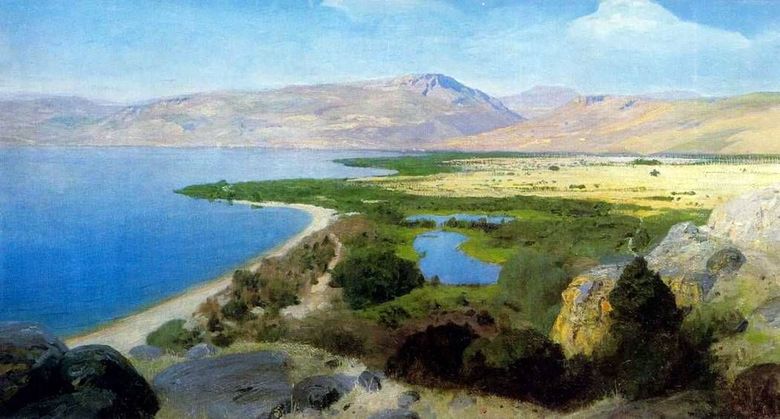
A contemporary and friend of Ilya Repin, Vasily Surikov, Viktor Vasnetsov, Vasily Dmitrievich Polenov entered Russian painting as the creator of landscapes filled with “true, subtle musical lyricism and the most elegant technique.” Lake Genisaret is located in the historic region of Palestine in Israel.
In the Bible, it is associated with many legends about the activities of Jesus Christ. Polenov visited here during his first trip to the East, undertaken in connection with the work on the painting “Christ and the sinner” to recreate the historically true situation in which the events depicted took place. The beauty of Lake Genesaret, reflections that Jesus Christ walked along its shores, helped the artist to create a majestically pacified landscape. In a desolate, desolate nature, perfect, eternal beauty is poured. The surface of the calm blue lake is almost immobile.
In the distance is a widely spread mountainous country; chains of low mountains go to the very horizon, drawing on the background of the sky with their smooth softened outlines. From the second half of the 90s of the XIX century, landscape painting began to fade into the background, being replaced by a new serious plan of Polenov – a cycle of paintings from the life of the Savior. The idea of its creation, apparently, originated from the artist in the period of work on the canvas “Christ and the sinner.” And since then, this intention has not left him for many years.
A new work dedicated to Christ, appeared in 1888 – the painting “On the Lake of Gennesaret”, or, as Polenov called it, “Christ is walking along the lake shore”. The gospel story, conveyed by the language of painting, is presented by the artist through the prism of an ideal, sublime landscape. The artist caught this subtle connection between the word and the painting, perhaps even when he saw the interior of the Russian church in Paris, in the design of which landscapes of Bogolyubov were used. “I don’t know whose thought,” he wrote about his impression in one of his letters to his relatives, “but it’s original and beautiful to see big landscapes in the church, you are transferred to nature and gospel narrations and legends.”
The assertion of the ideals of good and humanity, the search for spiritual perfection, characteristic of the cycle “From the Life of Christ”, are inseparable from Polenov’s view of nature, as the basis of the foundations of the formation of the moral image of man. “I love the Gospel narrative inexpressibly,” wrote Polenov, “I love this naive, truthful story, I love this purity and high ethics, I love this extraordinary humanity, which is permeated with all the teachings of Christ.”
 On the Lake of Tiberias (Genisaret) by Vasily Polenov
On the Lake of Tiberias (Genisaret) by Vasily Polenov Among the teachers by Vasily Polenov
Among the teachers by Vasily Polenov Golden Autumn by Vasily Polenov
Golden Autumn by Vasily Polenov Lac Genisaret – Vasily Polenov
Lac Genisaret – Vasily Polenov Who do people honor me by Vasily Polenov
Who do people honor me by Vasily Polenov Constantinople. Golden Horn by Vasily Polenov
Constantinople. Golden Horn by Vasily Polenov Christ and the sinner by Vasily Polenov
Christ and the sinner by Vasily Polenov Autumn in Abramtsevo by Vasily Polenov
Autumn in Abramtsevo by Vasily Polenov